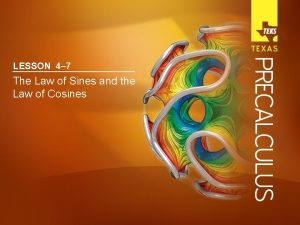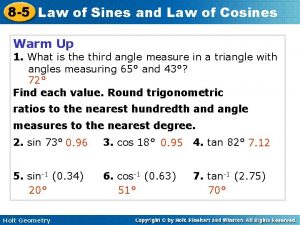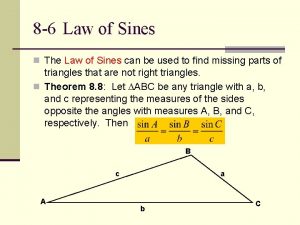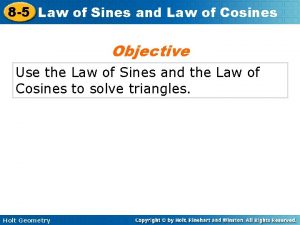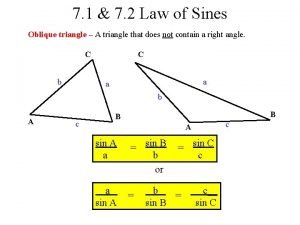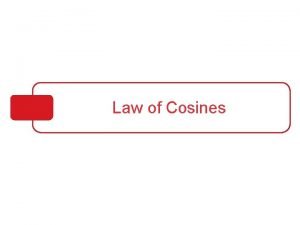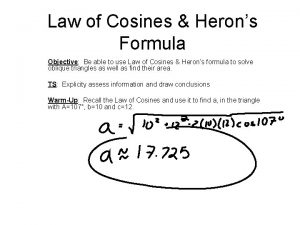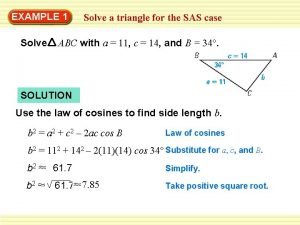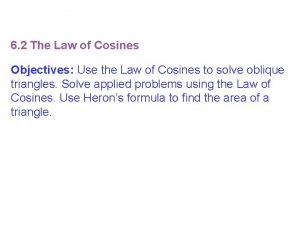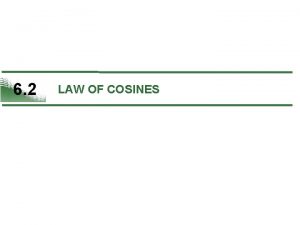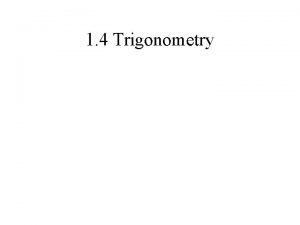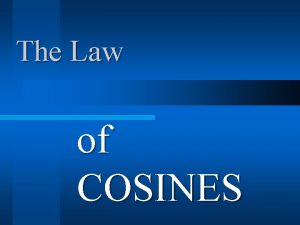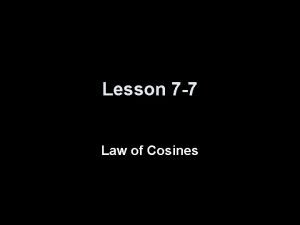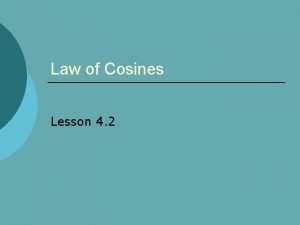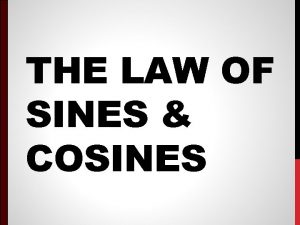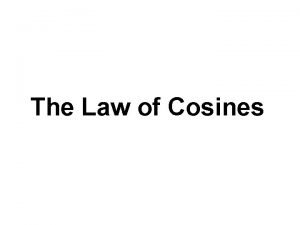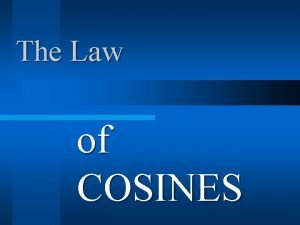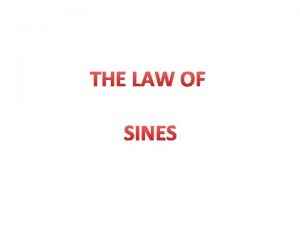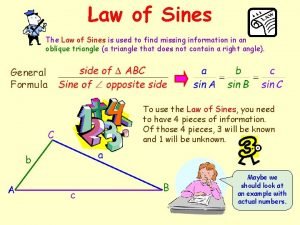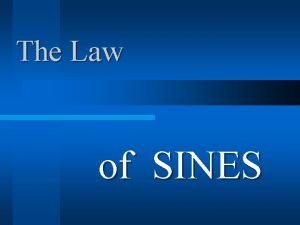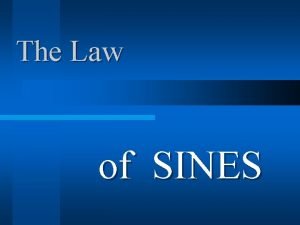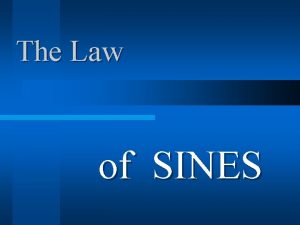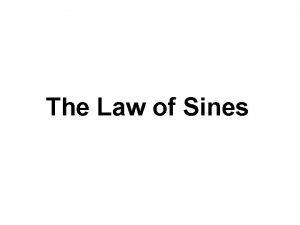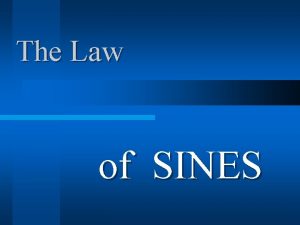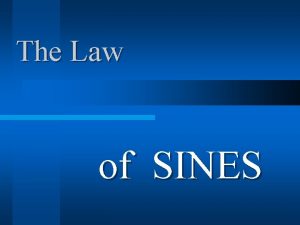Law of Sines and Law of Cosines An

















- Slides: 17

Law of Sines and Law of Cosines

An oblique triangle is a triangle that has no right angles. C a b A c B To solve an oblique triangle, you need to know the measure of at least one side and the measures of any other two parts of the triangle – two sides, two angles, or one angle and one side. Copyright © by Houghton Mifflin Company, Inc. All rights reserved. 2

The following cases are considered when solving oblique triangles. 1. Two angles and any side (AAS or ASA) A A c c B C 2. Two sides and an angle opposite one of them (SSA) c C 3. Three sides (SSS) b a c a 4. Two sides and their included angle (SAS) Copyright © by Houghton Mifflin Company, Inc. All rights reserved. c a B 3

The first two cases can be solved using the Law of Sines. (The last two cases can be solved using the Law of Cosines. ) Law of Sines If ABC is an oblique triangle with sides a, b, and c, then C b A h C a c h B Acute Triangle Copyright © by Houghton Mifflin Company, Inc. All rights reserved. b a c A Obtuse Triangle B 4

Example (ASA): Find the remaining angle and sides of the triangle. The third angle in the triangle is A = 180 – C – B = 180 – 10 – 60 = 110. C 10 a = 4. 5 ft b 60 A c B Use the Law of Sines to find side b and c. Copyright © by Houghton Mifflin Company, Inc. All rights reserved. 5

The Ambiguous Case (SSA) Law of Sines • In earlier examples, you saw that two angles and one side determine a unique triangle. • However, if two sides and one opposite angle are given, then three possible situations can occur: (1) no such triangle exists, (2) one such triangle exists, or (3) two distinct triangles satisfy the conditions.

The Ambiguous Case (SSA)

Example 3 – Single-Solution Case—SSA • For the triangle in Figure 6. 5, a = 22 inches, b = 12 inches, and A = 42 . Find the remaining side and angles. One solution: a b Figure 6. 5

Example 3 – Solution • cont’d Multiply each side by b Substitute for A, a, and b. B is acute. • Check for the other “potential angle” • C 180 – 21. 41 = 158. 59 (158. 59 + 42 = 200. 59 which is more than 180 so there is only one triangle. ) Now you can determine that • C 180 – 42 – 21. 41 = 116. 59

Example 3 – Solution cont’d • Then the remaining side is given by Law of Sines Multiply each side by sin C. Substitute for a, A, and C. Simplify.

Example (SSA): Use the Law of Sines to solve the triangle. A = 110 , a = 125 inches, b = 100 inches C a = 125 in b = 100 in 110 A c B C 180 – 110 – 48. 74 = 21. 26 Since the “given angle is already obtuse, there will only be one triangle. Copyright © by Houghton Mifflin Company, Inc. All rights reserved. 11

Example (SSA): Use the Law of Sines to solve the triangle. A = 76 , a = 18 inches, b = 20 inches C b = 20 in a = 18 in 76 B A There is no angle whose sine is 1. 078. There is no triangle satisfying the given conditions. Copyright © by Houghton Mifflin Company, Inc. All rights reserved. 12

C Example (SSA): Use the Law of Sines to solve the triangle. A = 58 , a = 11. 4 cm, b = 12. 8 cm a = 11. 4 cm 58 B 1 c A C 180 – 58 – 72. 2 = 49. 8 Check for the other “potential angle” C 180 – 72. 2 = 107. 8 (107. 8 + 58 = 165. 8 which is less than 180 so there are two triangles. ) Copyright © by Houghton Mifflin Company, Inc. All rights reserved. Example continues. 13

Example (SSA) continued: Use the Law of Sines to solve the second triangle. A = 58 , a = 11. 4 cm, b = 12. 8 cm B 2 180 – 72. 2 = 107. 8 C 49. 8 b = 12. 8 cm a = 11. 4 cm C 180 – 58 – 107. 8 = 14. 2 B 1 72. 2 58 c A 10. 3 cm C a = 11. 4 cm b = 12. 8 cm 58 B 2 Copyright © by Houghton Mifflin Company, Inc. All rights reserved. c A 14

Law of Cosines (SSS and SAS) can be solved using the Law of Cosines. (The first two cases can be solved using the Law of Sines. ) Law of Cosines Standard Form Copyright © by Houghton Mifflin Company, Inc. All rights reserved. Alternative Form 15

Example: Find the three angles of the triangle. C 8 6 A 12 B Find the angle opposite the longest side first. Law of Sines: Copyright © by Houghton Mifflin Company, Inc. All rights reserved. 16

C Example: Solve the triangle. 6. 2 Law of Cosines: A 75 9. 5 B Law of Sines: Copyright © by Houghton Mifflin Company, Inc. All rights reserved. 17
 4-7 the law of sines and the law of cosines answers
4-7 the law of sines and the law of cosines answers 8-5 law of sines and law of cosines
8-5 law of sines and law of cosines 8-6 the law of sines
8-6 the law of sines 8-5 law of sines and law of cosines
8-5 law of sines and law of cosines Classifying triangles maze answers
Classifying triangles maze answers Dot product rules
Dot product rules Law of sines and cosines word problems
Law of sines and cosines word problems Saa case example
Saa case example Law of cosines test
Law of cosines test Law of cosines sss
Law of cosines sss Area using law of cosines
Area using law of cosines Solve triangle sas
Solve triangle sas Unit 6 revised solving oblique triangles
Unit 6 revised solving oblique triangles Law of cosines sas
Law of cosines sas Law of cosines vectors
Law of cosines vectors Law of cosines sas
Law of cosines sas 7-7 practice the law of cosines answers
7-7 practice the law of cosines answers Lesson 4-2
Lesson 4-2
